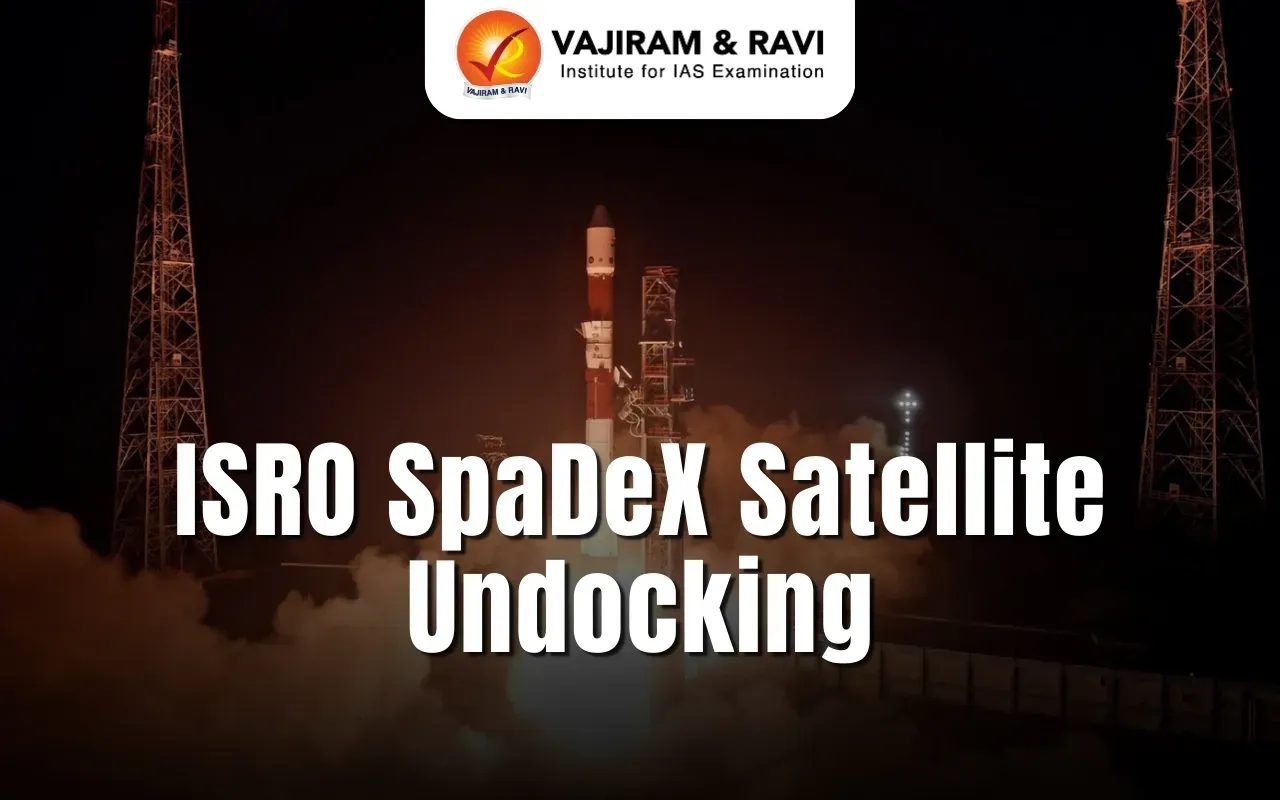What’s in Today’s Article?
- SpaDeX Satellites Latest News
- Introduction
- About the SpaDeX Mission
- Significance of this Capability
- ISRO’s Indigenous Docking System: A Major Innovation
- The Road Ahead: Further Refinements and More Experiments
- Conclusion
- ISRO’s SpaDeX Satellite Undocking FAQs
SpaDeX Satellites Latest News
- Nearly two months after the Indian Space Research Organisation (ISRO) successfully demonstrated its docking capability, it disengaged and undocked two satellites.
Introduction
- The Indian Space Research Organisation (ISRO) successfully undocked the SpaDeX (Space Docking Experiment) satellites SDX01 (Chaser) and SDX02 (Target) after nearly two months of testing their docking capabilities.
- The manoeuvre, which took place at 9:20 AM on March 14, 2025, marks India’s significant progress in autonomous docking and undocking technology.
- This accomplishment positions India as the fourth country after the United States, Russia, and China to develop this advanced space docking capability.
- The achievement is critical for future ISRO missions, including human spaceflight, lunar exploration, and the construction of India’s planned space station.
About the SpaDeX Mission
- SpaDeX is an ambitious ISRO mission designed to test India’s ability to autonomously dock and undock satellites in orbit. The experiment involved:
- Docking: Two 220-kg satellites, SDX01 and SDX02, were maneuvered into the same orbit and progressively brought closer until they were joined on January 16, 2025.
- Power Sharing: The mission demonstrated power-sharing capabilities, where both satellites operated as a single composite unit.
- Undocking: On March 14, the capture levers were released, and the satellites were commanded to separate, successfully completing the undocking operation.
- ISRO officials took their time before executing the undocking manoeuvre to ensure every step was thoroughly analysed, as this was the agency’s first attempt at such a mission.
Significance of this Capability
- Chandrayaan-4 and Lunar Sample Return Missions
- ISRO plans to launch Chandrayaan-4, a mission aimed at bringing back lunar surface samples. This will require two critical docking operations:
- In Lunar Orbit: The ascender module carrying Moon samples will dock with a transfer module.
- In Earth Orbit: The transfer module will dock with a re-entry module, which will carry the samples back to Earth.
- ISRO plans to launch Chandrayaan-4, a mission aimed at bringing back lunar surface samples. This will require two critical docking operations:
- The Bharatiya Antariksha Station (India’s Own Space Station)
- India is working on launching its own space station, the Bharatiya Antariksha Station, by 2035. This will consist of five separate modules that must be docked together in space to form the complete station.
- Human Spaceflight and Resupply Missions
- I21n future human spaceflight missions, docking and undocking will be crucial for sending astronauts to space stations and facilitating cargo transport, similar to how the International Space Station (ISS) functions.
ISRO’s Indigenous Docking System: A Major Innovation
- One of the highlights of the SpaDeX mission is the development of Bharatiya Docking System, which is:
- Inspired by International Standards: Similar to the International Docking System Standard used by spacecraft docking with the ISS.
- Designed with Simplicity: While the ISS docking system has 24 motors, ISRO’s system operates efficiently with just two motors.
- Androgynous Design: Both the Chaser and Target satellites have identical docking systems, making the process seamless.
- This indigenous innovation strengthens India’s self-reliance in space technologies and paves the way for future deep-space missions.
The Road Ahead: Further Refinements and More Experiments
- ISRO officials stated that they might conduct further docking and undocking experiments to refine the system’s accuracy.
- Exhaustive ground simulations and analysis were key to achieving this milestone in the first attempt itself.
- The organization is now focused on integrating docking systems into upcoming missions, including the Gaganyaan human spaceflight program, future lunar missions, and satellite servicing projects.
Conclusion
- The successful undocking of the SpaDeX satellites is a major milestone for ISRO, showcasing its growing expertise in space docking technology.
- This capability is essential for future lunar exploration, space station assembly, and human spaceflight missions.
- By developing its own docking system, India is strengthening its position as a key player in the global space industry.
- As ISRO continues its research and experimentation, SpaDeX lays the groundwork for a future where India can independently conduct complex space missions, marking a giant leap toward self-sufficiency in space exploration.
ISRO’s SpaDeX Satellite Undocking FAQs
Q1. What is the significance of ISRO’s SpaDeX mission?
Ans. SpaDeX (Space Docking Experiment) demonstrates ISRO’s ability to dock and undock satellites autonomously, a crucial step for future space station, lunar, and human spaceflight missions.
Q2. How does the SpaDeX undocking process work?
Ans. The undocking process involved extending SDX02’s robotic arm, releasing capture levers, and commanding the satellites to separate, allowing them to move independently in orbit.
Q3. Why is docking technology important for future ISRO missions?
Ans. Docking is essential for assembling space stations, lunar sample return missions like Chandrayaan-4, and resupply missions for human spaceflight programs.
Q4. How does ISRO’s docking system compare with international standards?
Ans. ISRO developed its Bharatiya Docking System, similar to the International Docking System Standard but simplified with just two motors instead of 24, making it a cost-effective and efficient solution.
Q5. What are the next steps after SpaDeX’s successful undocking?
Ans. ISRO plans to conduct further docking and undocking experiments to refine its precision before integrating the technology into major upcoming missions like Chandrayaan-4 and Gaganyaan.
Last updated on June, 2025
→ UPSC Notification 2025 was released on 22nd January 2025.
→ UPSC Prelims Result 2025 is out now for the CSE held on 25 May 2025.
→ UPSC Prelims Question Paper 2025 and Unofficial Prelims Answer Key 2025 are available now.
→ UPSC Calendar 2026 is released on 15th May, 2025.
→ The UPSC Vacancy 2025 were released 1129, out of which 979 were for UPSC CSE and remaining 150 are for UPSC IFoS.
→ UPSC Mains 2025 will be conducted on 22nd August 2025.
→ UPSC Prelims 2026 will be conducted on 24th May, 2026 & UPSC Mains 2026 will be conducted on 21st August 2026.
→ The UPSC Selection Process is of 3 stages-Prelims, Mains and Interview.
→ UPSC Result 2024 is released with latest UPSC Marksheet 2024. Check Now!
→ UPSC Toppers List 2024 is released now. Shakti Dubey is UPSC AIR 1 2024 Topper.
→ Also check Best IAS Coaching in Delhi






















